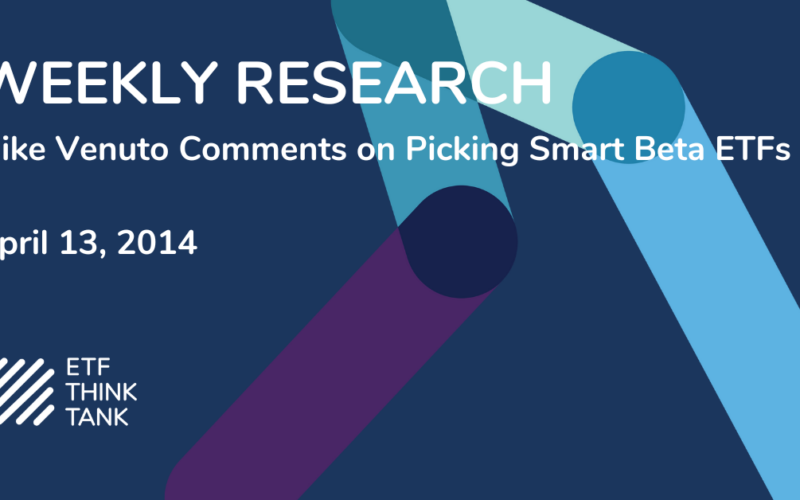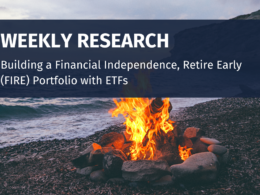Toroso Investment’s Mike Venuto says smart-beta ETFs are great tools, but it all hinges on the market environment.
Smart-beta ETFs may be all the rage, but they don’t make sense in every market environment, says Mike Venuto, chief investment officer at Toroso Investments, a New York-based advisory firm.
Arguing that the marketing spin surrounding these strategies can prevent investors from truly grasping how smart-beta funds can fit in a portfolio, Venuto warns that understanding the current macroeconomic environment is the key to using these strategies smartly.
Venuto, who was previously head of investments for Global X, now designs core asset allocation and fixed-income strategies for private wealth as well as institutional clients at Toroso. The Toroso CIO, who helped launch a multi-class mutual fund that comprises only ETFs, also stressed that smart-beta-type products are much needed in the fixed-income space.
ETF.com: Do you use smart-beta ETFs in your mutual fund?
Mike Venuto: Absolutely. We think there’s great value in what’s been classified as smart-beta ETFs. But we recently wrote a paper about smart beta because it is our understanding that everyone seems to define smart beta as anything other than traditional market-cap-weighted indexes. We felt that that’s too broad of a definition.
We agree that everything other than market-cap-weighted are nontraditional indexes, but we need to better define what subcategory of that we call smart beta.
We see it as indexes that have beta—that are focused on a traditional exposure but use something like fundamentals or dividends, or anything in that space, to reweight the index. We would put equal-weight, characteristic-based, risk-parity-based and fundamentally weighted all under nontraditional indexes, and only the latter would we call smart beta.
ETF.com: So, you define smart beta solely as fundamentally weighted ETFs. What do you see as their biggest appeal? Are they good for downside protection or to capture outperformance, or both?
Venuto: That’s an excellent question. They can be good for downside protection, or for generating alpha, but the portfolio manager’s job is to figure out what the current macroeconomic environment is, and which fundamentals should do well in that environment. These ETFs are valuable for both protection and enhancement, but it depends on the market.
Last year, for example, it didn’t matter that much. The stock market rallied 30 percent. But in a year when the market is moving sideways or down, fundamentals can matter a lot. The example that we would use is RevenueShares’ revenue-weighted indexes.
In today’s macroeconomic environment, one of the key aspects is that margins are stretched. Current net margins of the S&P 500 Index are more than 10 percent. The historical norm is around 5 percent. When we look at that, we think about the small-cap universe.
We think that what are likely to be acquisition targets are companies with good revenue and small net margins, because when they are acquired, the acquiring company can bring up those net margins.
Venuto (cont’d.): When you look at the iShares Russell 2000 ETF (IWM | A-83), you’re looking at net margins in the 7 percent range. So from 7 to 10 percent is not a very accretive transaction. But if you take the S&P 600 and reweight it for top-line revenue, you can get to net margins around 2.5 percent, which can be a 400 percent accretive transaction.
That’s what we mean by understanding the current environment and which fundamentals matter. The right fundamentals can offer downside protection as well as offer great upside opportunities.
ETF.com: Even though 2013 was perhaps not the best year for smart-beta ETFs, they attracted billions of dollars in net assets. We’ve heard a lot of projections for a market correction this year, so do you think 2014 could be a much more prospective year for smart-beta ETFs?
Venuto: Yes. They add a lot more value in markets that are volatile and sideways trending. But we believe these are really long-term tactical plays—they are not buy-and-hold-forever-type instruments. So again, you must understand the economic environment to decide whether it’s worth paying three or four times the expense ratio to own a smart-beta ETF. It has to be the right time, and that’s the job of the portfolio strategist.
ETF.com: What smart-beta ETFs do you like right now? What do you own?
Venuto: One that we own right now is the RevenueShares Small Cap ETF (RWJ | B-79), a revenue-weighted small-cap fund.
We also own a few ETFs that would fall under our characteristic-based definition. Those would be things like the PowerShares Buyback Achievers ETF (PKW | A-94), and the Guggenheim Spin-Off ETF (CSD | C-48). We like those characteristics at this time, and they’re both core holdings for us.
ETF.com: Smart-beta ETFs only represent about 10 percent of total ETF assets. In particular, there are relatively few in the fixed-income space. Is that where there’s most opportunity/need for growth in terms of product development?
Venuto: I think there’s been more growth in the equity side rather than the fixed-income side because of 2008, and fixed income has done so poorly relative to stocks. But if you think about where we are in the debt cycle, you could argue smart beta could be even more valuable on the fixed-income side.
There’s really a need for more. Market-cap weighting in bonds doesn’t make a lot of sense. We see that with the iShares iBoxx $ High Yield Corporate Bond ETF (HYG | B-75) and the SPDR Barclays High Yield Bond ETF (JNK | B-61)—they had to recently change the indexes on those funds.
The PowerShares Fundamental High Yield Corporate Bond Portfolio (PHB | B-74) is also interesting, because if you look at the top holdings, most of them are names like GM—a company that has already been saved by the government.
In a way, you can get high-yield exposure with a quasi-government backing. It’s an interesting place. We don’t have the answer on how you would make smart-beta versions of fixed income—we have some ideas, but no answers. But it needs to be done.
ETF.com: In a broader sense, what does your mutual fund asset class allocation look like these days?
Venuto: Right now we are overweighting equities and commodities, and near our minimum on bonds and cash. Our performance so far this year has been spectacular—the market is down; we are up.












